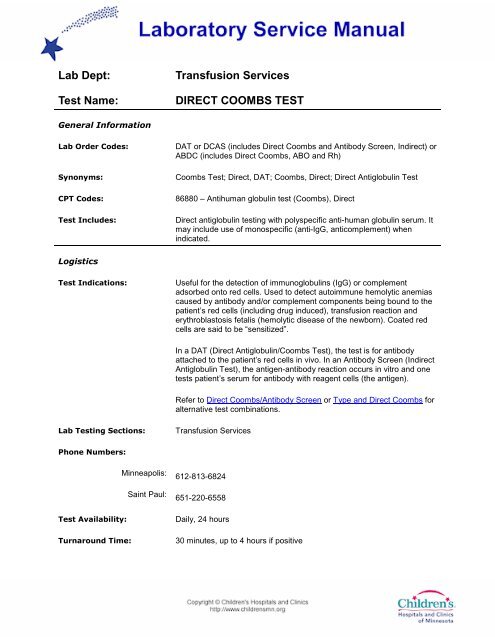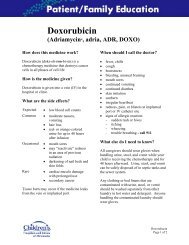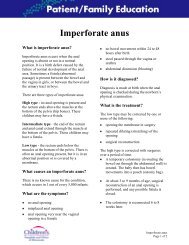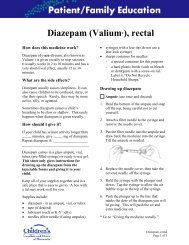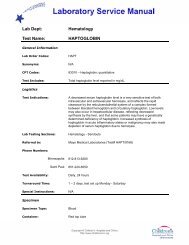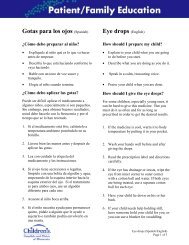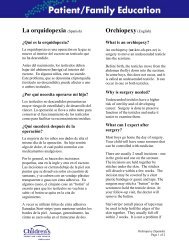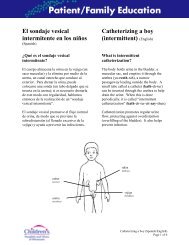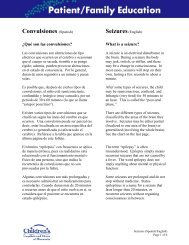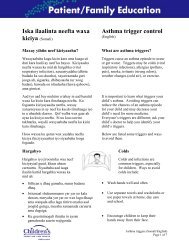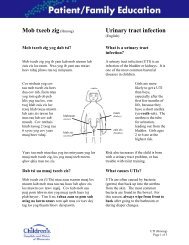Direct Coombs Test
Direct Coombs Test
Direct Coombs Test
You also want an ePaper? Increase the reach of your titles
YUMPU automatically turns print PDFs into web optimized ePapers that Google loves.
Special Instructions: Provide diagnosis, transfusion history, and pertinent medications to the<br />
laboratory. Additional specimen may be requested if elution studies are<br />
indicated.<br />
Specimen<br />
Specimen Type: Whole blood<br />
Container: Lavender top tube (EDTA)<br />
Draw Volume: 0.5 mL blood (small EDTA) or 2 mL blood (large EDTA)<br />
Collection: All specimens submitted to the Transfusion Service must be<br />
appropriately labeled at the bedside with the time and date of collection,<br />
and the signature of the individual collecting the specimen. A completed<br />
order, either through the HIS or general requisition must accompany<br />
each specimen. It is not always necessary to collect a new sample prior<br />
to the provision of blood for patients. Consult with the Transfusion<br />
Service prior to collecting additional samples if the status is unknown.<br />
Special Processing: Lab Staff: Refrigerate specimen<br />
Patient Preparation: Refer to Collection of Patient Specimens for full details. The patient must<br />
be positively identified when the specimen is collected. The label on the<br />
blood specimen must correspond with the identification on the patient’s<br />
Medical Record wrist or ankle band (or ED ID) and on the<br />
physician’s/practitioner’s orders. The specimen must be timed, dated<br />
and signed by the phlebotomist at the bedside.<br />
Sample Rejection: Gross hemolysis; sample placed in a serum separator tube; specimen<br />
tube not properly labeled<br />
Interpretive
Reference Range: Negative<br />
Additional Information: Drugs, including the penicillins and<br />
cephalosporins, α-methyldopa, levodopa, quinidine, insulin, mefenamic<br />
acid, sulfonamides, tetracycline, and others may cause positive direct<br />
antiglobulin/<strong>Coombs</strong> tests. Many positive direct antiglobulin tests are due<br />
to methyldopa. Methyldopa antibodies are predominantly IgG; about 1%<br />
of patients on methyldopa develop hemolytic anemia, but as many as<br />
15% develop a positive DAT. Although drugs and alloantibodies may<br />
cause a positive direct antiglobulin test, the majority of patients have no<br />
such association. It is unusual to find a significant antibody in the eluate<br />
from a positive direct antiglobulin test. Broad spectrum or polyspecific<br />
antisera contain both anti-IgG and anti-C3d. Anti-IgG may be used to<br />
determine if the cells are coated with IgG. If indicated, red cell elutions<br />
and/or an indirect antiglobulin test (antibody screen) and antibody<br />
identification are included in the work-up of a positive direct antiglobulin<br />
test. In case of Hemolytic Disease of the Newborn or autoimmune<br />
hemolytic anemia, an eluate from the patient’s red cells sometimes<br />
shows antibody specificity.<br />
Limitations: False-positives may occur with cold autoagglutinins and when the serum<br />
contains large amounts of paraprotein. Use of red top tubes or serum<br />
separator tubes may cause false-positive reactions, particularly if tubes<br />
have been refrigerated. Newborn’s cells may have a negative direct<br />
antiglobulin test in ABO hemolytic disease. Wharton’s jelly from cord<br />
samples can cause false-positives. 2 – 4% of patients with clinical<br />
autoimmune hemolytic anemia have a negative <strong>Direct</strong> <strong>Coombs</strong> test.<br />
Methodology: Hemagglutination Antiglobulin test<br />
References:<br />
Bator S, Litty C, Dignam C, et al (1994) Current utilization of the direct<br />
antiglobulin test investigation: results of a hospital survey. Transfusion<br />
34(5):457-8<br />
Canadian Red Cross Society (1980) Serological and Immunological<br />
Methods of the Canadian Red Cross Blood Transfusion Service, 8 th ed,<br />
Toronto, Canada. The Canadian Red Cross<br />
Freedman J (1979) False-positive antiglobulin tests in healthy subjects<br />
and in hospital patients. J Clin Pathol 32:1014-18<br />
Huh YO, Lui FJ, Rogge k, et al (1988) Positive direct antiglobulin test<br />
and high serum immunoglobulin G values. Am J Clin Pathol 90(2):197-<br />
200


